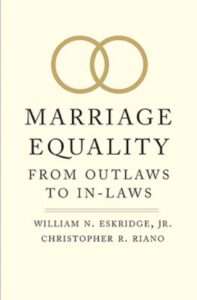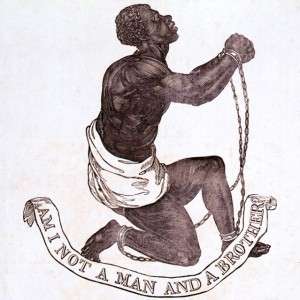The Volokh Conspiracy
Mostly law professors | Sometimes contrarian | Often libertarian | Always independent
Lessons of the Legal and Political Struggle for Same-Sex Marriage
Drawn from William Eskridge and Christopher Riano's comprehensive new book on the subject.

One of the very few positive aspects of the awful Covid pandemic is the opportunity to have big-name "virtual" guest-speakers in college and law school classes. Tomorrow's guest speaker in my Constitutional Law II class will be Prof. William Eskridge, of Yale Law School, probably the nation's leading expert on the law and politics of same-sex marriage. He will be speaking about his recent book Marriage Equality: From Outlaws to In-Laws (coauthored with Christopher Riano). It is the closest thing we have to a definitive comprehensive account of how same-sex marriage went from being a radical fringe idea to a recognized constitutional right endorsed by a Supreme Court decision.
A brief anecdote illustrates how swift that transformation was. In 1992, when I was a college freshman, a gay classmate I will refer to as "Bob" asked me what rights I thought gays and lesbians should have. "The same rights as everyone else," I answered.
Perhaps sensing an effort at evasion, Bob pressed on and asked what exactly I meant by that. I said it meant anti-sodomy laws should be abolished (many states still had them), that gays and lesbians should be allowed to serve openly in the military (a hotly debated issue at the time, culminating in the "don't ask, don't tell" compromise of 1993), and a few other similar points.
It did not occur to me to mention same-sex marriage - an idea I probably hadn't even heard of yet. Perhaps more tellingly, it apparently didn't occur to Bob to ask about it! He seemed happy with the answer I gave, even though it omitted the issue. In 1992, even many politically aware people (including, probably, a good many gays and lesbians) barely knew that same-sex marriage was even an option.
As Eskridge and Riano document in their book, the idea of same-sex marriage long predated that time. But few Americans were aware of it, beyond the relatively narrow circle of activists and policy experts who closely followed gay rights issues.
Within a few years, that changed. By 1995, same-sex marriage was a major focus of public debate, though majority public opinion was strongly opposed to it. I myself was happy to endorse same-sex marriage as soon as I heard of the concept (probably around 1994 or so). But that was very much a minority view at the time.
While a few state supreme courts ruled in favor of a right to same-sex marriage under their state constitutions, majority national opinion remained opposed up until around 2012. Even such liberal politicians as Barack Obama found it advantageous to oppose it themselves, or at least pretend to do so.
Yet public opinion ultimately shifted decisively in favor of same-sex marriage, and in Obergefell v. Hodges (2015), the Supreme Court ruled that laws banning same-sex marriage are unconstitutional. That happened only a little more than two decades after my little discussion with Bob.
What caused this dramatic transformation? If you want to know the answer, read Eskridge and Riano's book! It may well be, however, that we are still too close in time to these events to get proper historical perspective on them. Legal scholars, historians, and social scientists will likely debate their implications for many years to come.
For now, I would like to mention two key lessons that - at least to my mind - permeate Marriage Equality.
First, legal and political action are mutually reinforcing strategies for achieving constitutional reform. Again and again, Eskridge and Riano describe how victories in court set the stage for wins in the political arena, and vice versa.
Early pro-same-sex marriage decisions in state courts, such as the Massachusetts Supreme Judicial Court ruling in Goodridge v. Department of Public Health (2003) were made possible by the (partial) success of the gay rights movement's efforts to shift public opinion about gays and lesbians generally. Those rulings, in turn, gave a further boost to the gay rights movement, and helped pave the way for further shifts in public opinion, and further favorable judicial rulings - eventually culminating in Obergefell. The "normalization" of same-sex marriage required a combination of legal and political action, not an exclusive focus on one or the other. Far from being mutually exclusive, as some scholars argue, these two strategies were mutually reinforcing.
Eskridge and Riano are not the first scholars to chronicle such a process. Earlier writers found similar patterns in the civil rights movements, the women's rights movement, the gun rights movement, and others. I myself have written about it in the context of the struggle to strengthen constitutional protection for property rights. But Marriage Equality is a particularly thorough and insightful account of how that synergy worked in one of the most high-profile constitutional movements of our time.
The second lesson is that the same-sex marriage movement did not triumph by advocating the importance of validating a distinct LGBT cultural identity, but rather by emphasizing how same-sex marriage is fundamentally similar to opposite-sex marriage; and gays and lesbians, more generally, are fundamentally similar to heterosexuals.
As an Iowa Supreme Court ruling quoted by Eskridge and Riano put it, the plaintiffs in the case were "in committed and loving relationships, many raising families, just like heterosexual couples." Similar statements abound throughout Marriage Equality. Ultimately, the same-sex marriage movement triumphed by focusing on universal principles of liberty, justice, and equality, rather than on a distinctive group identity.
This, too, is far from unique to the struggle for same-sex marriage. We see the same pattern in the success of the antislavery movement, and movements for racial and gender equality. Elsewhere, I have argued that a similar strategy should be adopted by advocates of free international migration regardless of morally arbitrary circumstances of parentage and place of birth.
It is no accident that the antislavery movement's most famous and successful image was this 1787 Josiah Wedgewood image of a black slave, asking "Am I not a man and a brother?"
Wedegwood drove home the point that there is no morally significant distinction between blacks and whites, and thus no good reason to deny the former the same liberty as that claimed by the latter.
Similarly, the same-sex marriage movement (and the gay rights movement generally) emphasized how gays and lesbians are also our brothers and sisters (sometimes literally so!), and that differences in sexual orientation are ultimately superficial in nature. Thus, there is no good reason to deny gays and lesbians the same rights for their relationships as those claimed for heterosexual ones.
This lesson may seem blatantly obvious. But it is deeply at odds with the positions of many identity politics movements on both the "woke" left, and the nationalist/identitarian right, which focus on the supposed uniqueness and incommensurability of different ethnic, racial, cultural, and religious groups.
Much more can be learned from Eskridge and Riano's excellent book. For a sampling of some of the other issues it raises, see this recent symposium about it at the Balkinization site.



Show Comments (233)